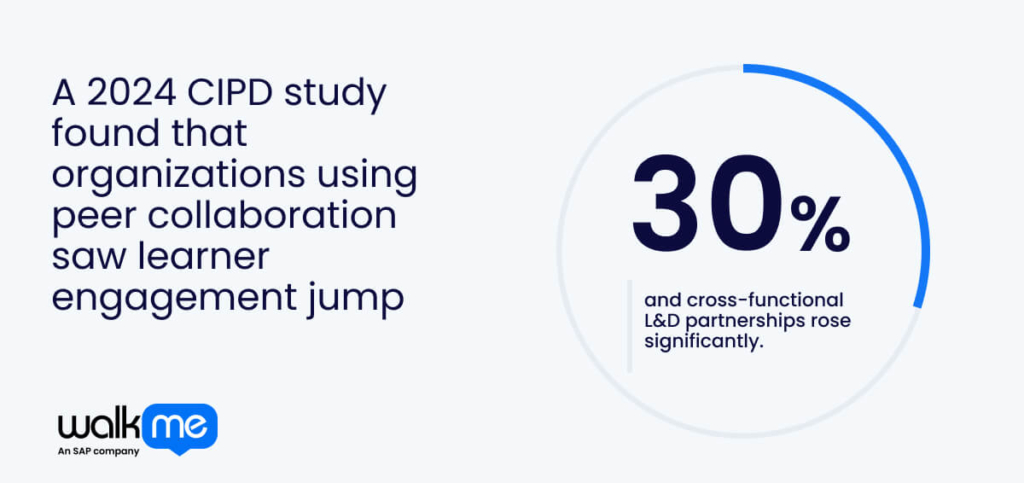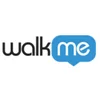Social learning throws out the old “sit and listen” model and emphasizes the use of shared employee experience, collaboration technology, and real conversation as the backbone of meaningful enterprise learning.
Allied Market Research says the social learning platforms market was worth $110.2 billion in 2023 and is on track to almost double by 2032. These figures might surprise you and suggest that organizations are realizing they learn better together than alone.
With that in mind, this article explores the fifteen best social learning platforms transforming employee collaboration, engagement, and peer-to-peer learning in 2025.

1. Udemy Business
- Review Rating: 4.5/5 (660 Reviews)
- Suitable For: Collaborative skill building
The first entry on our list is Udemy Business, which earns the top spot for how naturally it blends social learning into the flow of work. Employees tend to learn and forget, but with Udemy, they share insights, join discussions, and learn from each other in real-time.
The platform transforms passive video lessons into active knowledge exchanges, turning every course into a conversation. That’s what makes Udemy Business more than a content library; it’s a social learning ecosystem built for modern teams.
2. Coursera for Business
- Review Rating: 4.5/5 (458 Reviews)
- Suitable For: Peer-reviewed learning
A contender for the number one spot, Coursera for Business, stands out for treating social learning as an ongoing, peer-reviewed process. Learners engage through mentor feedback and global discussion boards tied to each course, creating an active exchange of ideas across industries.
In an enterprise context, this means employees can challenge, debate, and apply expert content collectively. It’s a great way to turn knowledge into shared intelligence that moves teams forward rather than creating competition.
3. 360Learning
- Review Rating: 4.6/5 (521 Reviews)
- Suitable For: Co-created team learning
360Learning takes social learning and makes it the entire foundation, not just a feature. It allows employees to teach each other through co-created courses, comments, and discussion threads, transforming ideas and concepts from the everyday work floor into living lessons that grow with the team.
Instead of learning from a faceless program, people learn from colleagues who’ve done the work themselves. That’s why it works so well in fast-moving companies where knowledge doesn’t sit in a file but evolves and strengthens the organization from the inside out.
4. TalentLMS
- Review Rating: 4.6/5 (785 Reviews)
- Suitable For: Interactive team training
TalentLMS flips the idea of traditional employee training on its head by making conversation part of the lesson. Employees can share wisdom, challenge each other’s approaches, and solve problems together. Each course is a living discussion, with learning emerging from debate, feedback, and real-world examples.
Teams uncover solutions collaboratively, spotting gaps faster than any static module could reveal. In innovation-led environments, TalentLMS is key to making learning a byproduct of interaction rather than a solo task.
5. iSpring Learn
- Review Rating: 4.6/5 (113 Reviews)
- Suitable For: Contextual social learning
Our next entry is iSpring Learn. It’s a particularly dynamic platform because it blends structured learning with real-time social interaction, turning modules into a space where employees can experiment and build understanding.
Every comment, annotation, and shared insight is integrated into a living knowledge network, giving leaders clear visibility into both skill mastery and team collaboration. What employees love most about iSpring Learn is how it creates a culture where learning happens in context, is immediately applicable, and grows stronger with every conversation.
6. Moodle
- Review Rating: 4.1/5 (435 Reviews)
- Suitable For: Hands-on collaborative learning
Moodle immerses teams in a hands-on learning ecosystem where conversation and contribution drive work progress. Employees engage in shared projects, collaborative exercises, and feedback loops that shape understanding as much as the content itself.
This platform doesn’t focus on completing exercises like traditional content. Instead, it creates a living classroom where ideas are tested, refined, and applied, demonstrating how social interaction leads to tangible skill growth and makes every connection a vector for learning.
7. Docebo
- Review Rating: 4.3/5 (667 Reviews)
- Suitable For: Community-driven training
Nearing the mid-point of our list, Docebo is a heavy hitter in the industry, recognized for its robust social learning capabilities that promote collaboration and knowledge sharing among learners. The platform’s Learner Communities feature empowers organizations to create collaborative learning experiences, allowing learners to engage with peers, share insights, and co-create content.
Docebo enables organizations to create a culture of continuous employee training, driving both learner success and business impact. A commitment to social learning, combined with its other innovative features, positions Docebo as a leader in the learning management system (LMS) space.
8. Absorb LMS
- Review Rating: 4.6/5 (783 Reviews)
- Suitable For: Gamified peer engagement
Social learning works best when collaboration isn’t an afterthought, and Absorb LMS is the ultimate player in turning peer interaction into a motivating experience. It uses gamification, newsfeeds, and leaderboards, incorporating them into daily training to keep learners engaged while providing managers with insights.
Integrated mentoring through platforms like Together adds depth, enabling better knowledge management and guidance. Automation reduces administrative overhead, so programs run without constant oversight. The platform balances scale with personalization, making it ideal for organizations that want learning to feel alive and interactive.
9. LearnUpon
- Review Rating: 4.6/5 (184 Reviews)
- Suitable For: Guided group learning
LearnUpon’s USP is turning enterprise learning into a shared journey, where employees discover, practice, and discuss skills together. Switch on the autopilot feature and cut the admin workload automation technology to enroll individual learners or groups into courses.
New hires ramp up fast, teams collaborate through social features, and curiosity drives self-directed growth. Automated assessments, gamified experiences, and interactive eLearning keep engagement high, while every exchange maps expertise.
10. Miro
- Review Rating: 4.7/5 (9,362 Reviews)
- Suitable For: Visual collaboration learning
One of the most popular entries on our list, coming in at number ten, is Miro. Unlike traditional training tools, it uses a visual and interactive medium where employees collaborate in real time. Whiteboards, templates, and sticky-note workflows let teams brainstorm, map processes, and solve problems together.
Its intuitive interface encourages cross-functional teams to share insights and solve problems together, making collaboration itself a core part of learning. Organizations looking to embed knowledge-sharing into daily processes, spark conversations, and capture ideas, Miro ensures learning happens naturally as part of getting things done.
11. Eduflow
- Review Rating: 4.8/5 (2 Reviews)
- Suitable For: Co-creation learning hub
Coming in at number 11, because in business, the best ideas rarely fit neatly into a top ten, Eduflow flips traditional training on its head. It’s built for co-creation, letting teams contribute content, challenge assumptions, and learn from each other as core concepts.
Knowledge is built collectively and not handed down, meaning employees internalize concepts faster while shaping the learning experience themselves. With a focus on peer-review collaboration, employees learn to think through each other’s perspectives, strengthening judgment and communication in ways no static course ever could.
12. Mighty Networks
Number twelve on our list, Mighty Networks, uses community as its structural advantage. Employees can form interest-driven cohorts, share insights, and access curated learning paths without the noise of endless chat threads.
Automated enrollment and tracking cut admin overhead, letting managers focus on skill growth and engagement. Enterprises can use Mighty Networks to create an environment where social learning scales and advanced learning and development (L&D) projects can be developed.
13. Disco
- Review Rating: 4.6/5 (22 Reviews)
- Suitable For: Knowledge sharing platform
Number thirteen on our list is anything but unlucky. Disco excels at making expertise visible across teams and departments, capturing questions, answers, and even insights. Employees engage naturally, contributing knowledge where it’s most useful, while managers can intervene to identify knowledge gaps before they become blockages.
Disco’s idea of social learning doesn’t interrupt work as it integrates, highlights, and measures impact, helping businesses use collective intelligence without forcing formal training or adding extra admin.
14. BetterMode
- Review Rating: 4.7/5 (116 Reviews)
- Suitable For: Embedded work learning
Our penultimate entry, BetterMode, is designed for organizations that want social learning to be woven into work communities. Employees can pose questions, share wisdom, and refine solutions in a living knowledge base, while leaders gain visibility without micromanaging.
Unlike stationary forums, it prioritizes quality over volume, highlighting expertise, nudging collaboration, and increasing organizational memory. Every interaction leads to smarter decision-making and breeds a culture where learning is both social and strategically aligned.
15. NovoEd
- Review Rating: 4.6/5 (39 Reviews)
- Suitable For: AI-enhanced mentorship
Rounding out our list, NovoEd elevates social learning into a strategic advantage for businesses that take people seriously. Every feature is streamlined to engage users and build social empowerment. What sets this platform apart is its Mentor+ feature, which pairs AI-matched mentor-mentee relationships with evidence-based feedback and action-item tracking.
Switch on AI tools to cut administrative workload while employees self-enroll, practice, and learn together. The platform also scaffolds career growth, strengthens leadership pipelines, and connects learning outcomes directly to measurable business impact.
Key takeaways
Social learning comes in many forms, from LMS platforms and peer collaboration tools to visual boards and AI-powered mentorship hubs.
We’ve put together the table below so you can take a glance at the top platforms, see what they do best, and understand where they deliver the most value, without wading through long specs.
| Platform | Focus | Key Features |
| Udemy Business | Collaborative skill building | Real-time discussions, shared insights |
| Coursera for Business | Peer-reviewed learning | Mentor feedback, discussion boards |
| 360Learning | Co-created team learning | Co-created courses, comments, and discussion threads |
| TalentLMS | Interactive team training | Debates, feedback, and collaborative problem-solving |
| iSpring Learn | Contextual social learning | Real-time interaction, annotations, integrated insights |
| Moodle | Hands-on collaborative learning | Shared projects, collaborative exercises |
| Docebo | Interest-based cohort | Learner communities, knowledge sharing |
| Absorb LMS | Gamified peer engagement | Gamification, leaderboards, mentoring |
| LearnUpon | Guided group learning | Automated enrollment, gamified experiences |
| Miro | Visual collaboration learning | Whiteboards, templates, and real-time brainstorming |
| Eduflow | Co-creation learning hub | Peer-reviewed collaboration, content creation |
| Mighty Networks | Interest-based cohorts | Curated learning paths, automated tracking |
| Disco | Knowledge sharing platform | Expertise visibility, Q&A capture |
| BetterMode | Embedded work learning | Living knowledge base, collaboration nudges |
| NovoEd | AI-enhanced mentorship | AI mentor matching, feedback tracking |
A 2024 CIPD study found that organizations using peer collaboration saw learner engagement jump 30%, and cross-functional L&D partnerships rose significantly. The data shows that by integrating social interaction into learning, silos dissolve and teams learn as a unified entity.

Social learning platforms take an allied approach to learning. Mistakes are quickly learned from and shared, while ideas flow between departments with unmatched synchronization.
In this regard, businesses use social learning to create a living network of knowledge, where employees collectively strengthen the company and accelerate collaboration across every partnership and function.
The following key features define how social learning platforms transform learning methods in the workplace:
Peer review
Social learning platforms use peer review to create a living feedback loop. Employees critique, advise, and validate each other’s work, accelerating skill mastery while building trust, accountability, and a culture of shared expertise across teams.
Discussion boards and forums
Discussion boards open up the conversation and help employees struggling with isolated tasks. Insights are shared and questions are posed to spark problem-solving and debate. In this way, solutions are uncovered faster while creating a permanent record of collaboration.
Multiple integrations
Integrations connect social learning platforms with existing LMS, HR systems, and external tools. This means connected workflows, reduced admin friction, and the ability for businesses to use existing data to deliver smarter, more measurable learning experiences.
Cohort-based courses
Cohort-based courses harness collective momentum as teams progress together through structured learning, sharing experiences, and accountability. This facet combines expert guidance with peer learning to maximize engagement and real-world skill application.
Social learning platforms put real-world collaboration and problem-solving front and center. Understanding the benefits is crucial because companies that use social learning experience faster skill adoption and measurable outcomes across various business areas.
Here are the benefits of social learning platforms:
- Interactive learning that sticks: Teams debate, test, and refine ideas together, accelerating skill retention and practical application.
- Shared collaboration: Expertise flows across departments, reducing repeated errors and increasing operational efficiency.
- Personalized skill paths: Employees pursue learning aligned with real responsibilities, improving relevance and confidence.
- Team-powered growth: Cross-department projects act as live learning labs, strengthening capability and organizational alignment.
- Mobile learning anytime: Employees convert downtime into productive skill-building moments.
- Actionable metrics: Analytics reveal performance gaps and top performers, guiding targeted development.
- Relationship building: Mentorship, peer feedback, and networks enhance trust and knowledge transfer.
- Real-world problem solving: Teams tackle live challenges collectively, embedding solutions into workflows.
Choosing the right social learning platform can make a huge difference. Most businesses tend to rush into structures or frameworks that haven’t been fully figured out. It’s the companies that ground themselves in the research and development phase that truly see the benefits of social learning.
And with Gartner revealing that 85% of business leaders expect a surge in skills development over the next three years, driven by AI and digital transformation trends, organizations will need employees who can adapt quickly.
When choosing a social learning platform, look beyond flashy interfaces and prioritize those that integrate with existing systems, support peer-to-peer collaboration, deliver measurable outcomes, and scale as your business matures.
Consider your team’s learning needs, the type of content they engage with most, and how the platform creates interactions at work.
FAQs
A social learning platform is a digital space where learning happens through social collaboration, and not just static content or courses. Social learning platforms use peer feedback, shared projects, and open discussion to engage users and create structured learning moments. Organizations are starting to place more value on social learning as a method to reskill and upskill employees.
Social learning platforms track actions such as course completion, discussion participation, peer feedback, and content creation. Analytics dashboards show who is active, where learners struggle, and how skills are developing over time. This gives managers clear insight into engagement and ensures learning translates into real workplace impact.
Yes. Most modern social learning platforms connect with LMS, HR systems, and other enterprise tools. Integration allows data flow, automated enrollment, and unified reporting. Employees access everything in one place, while managers track progress without disrupting workflows, enabling faster, more effective adoption.
Organizations that rely on collaboration, fast skill adoption, and knowledge sharing benefit most. This includes tech companies, consulting firms, healthcare networks, and global enterprises. Social learning platforms accelerate onboarding and keep skills current in dynamic industries where adaptability and peer collaboration drive performance.

